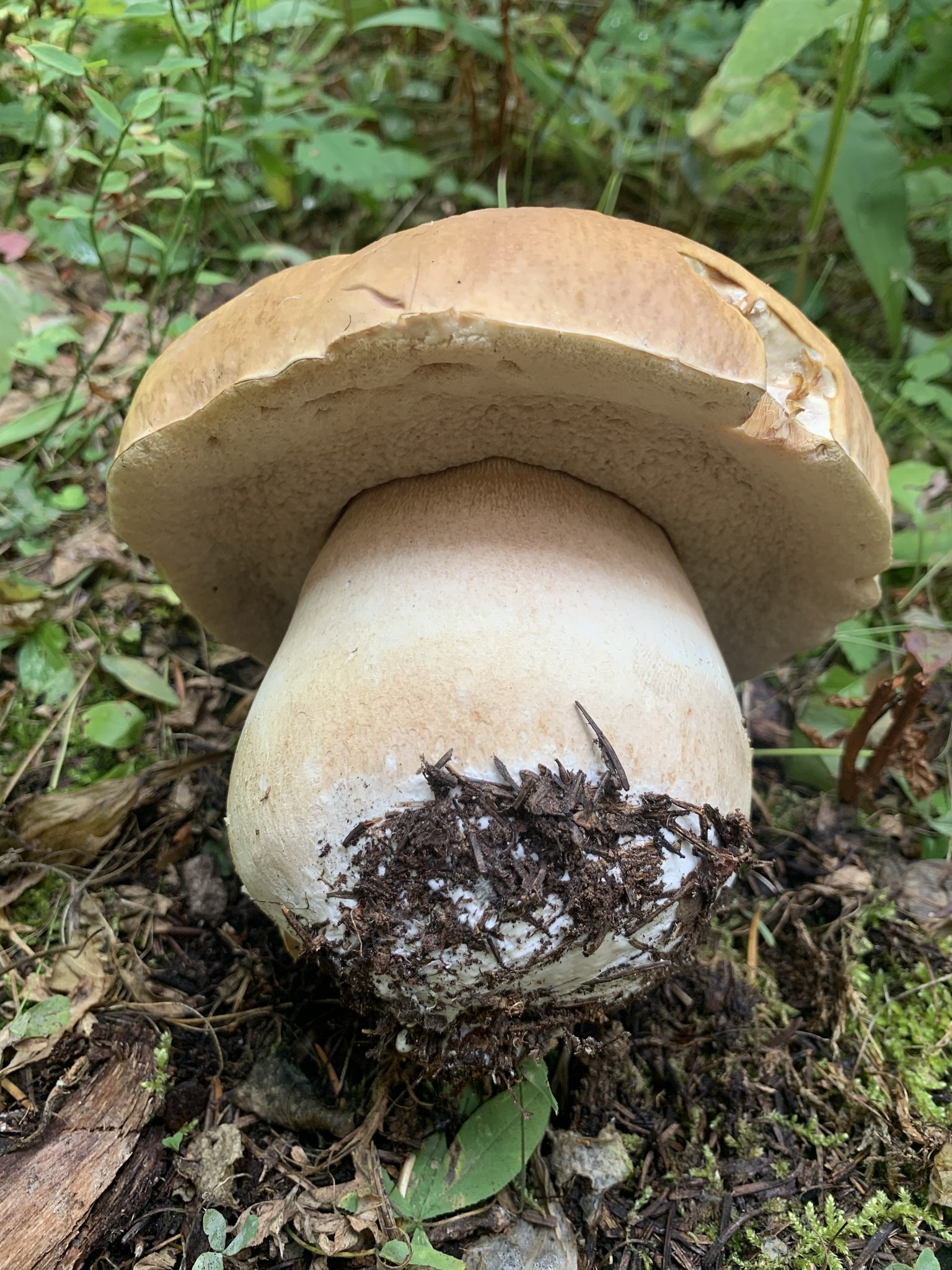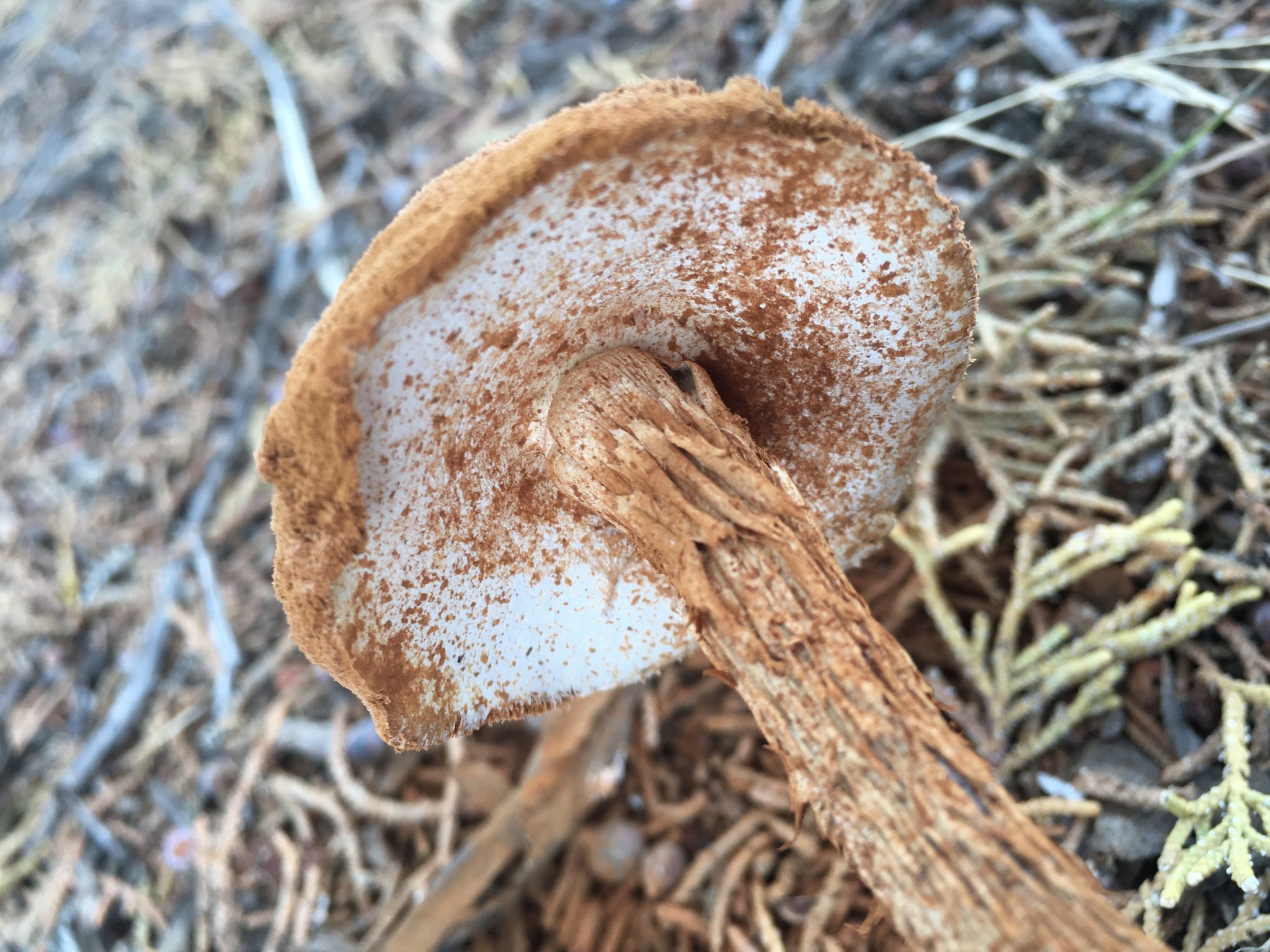High Desert Mycology
By Ben Snyder, January, 2025
The diversity of life on Earth is often described with reference to our "flora and fauna," but this leaves out an extremely important kingdom of organisms that are essential for all life on our planet - fungi! Though we often associate fungi and the mushrooms they produce with moisture and thus wet times of year and generally wetter ecosystems, it's important to remember that our fungal friends are an irreplaceable link within High Desert ecosystems as well - this article will lay out some basic facts about fungi and explain what some of the most common species are up to here in central Oregon.
Are mushrooms and fungi the same thing? They are related terms, but it is helpful to be specific when we're talking about these important organisms. The fleshy structures that people commonly refer to as mushrooms are in fact just the reproductive parts of large, cryptic networks of fibrous strands. The individual strands themselves are called hyphae, the larger network of strands is called mycelium. The entirety of the mycelium, any mushrooms being produced, and any other internal structures comprise what we might think of as an individual example of a fungus. It might help to visualize fungi like an apple tree, only the branches, trunk, and the whole "tree" element is buried and just the apples emerge to be seen when they are ripe.
These "apples" are the mushrooms. Often they are quite short lived, maybe only a few hours to several days before they rot or are consumed by animals. During that short period of time they exist to spread the fungal mycelium to new suitable locations - they do this by shedding billions and billions of reproductive spores into the air, onto passers by, or even into the water. The spores are produced by specialized structures on the spore bearing surface of the mushroom, called the hymenophore. We most often think of mushrooms with gilled hymenophores, but these spore ejecting surfaces can be smooth (many polypores), toothed (hedgehog mushrooms, etc), or tubed (boletes, etc). When the spores land in a suitable location they germinate into new hyphae strands and combine with the hyphae from other spores to produce a distinctly new mycelium. Reproduction in fungi can be complicated and only sometimes mirrors the basic elements of reproduction in animals, but the above description is one of the most basic ways it can work.
Just because you don't see a mushroom in a particular spot at a particular time of year doesn't mean there are not fungi present - in fact you're almost certainly walking over dozens or hundreds of different species of fungal mycelium at any given time you're out in the wild! The fact that most mushrooms are ephemeral and the vast majority of the actual fungal organism is buried within soil, wood, or other materials can make them hard to observe, hard to study, and unfortunately harder for most people to keep in mind or fully appreciate.
Generally speaking most kinds of fungi can be classified into three separate groups based on how they take in their energy. First are the parasites - these species extract energy from other living organisms. Most often they are parasitic on plants, but some species are parasitic on other fungi or even animals. In the forests of the high desert one often finds mushrooms like Armillaria (Honey Mushrooms) growing at the base of hardwoods or conifers, a sign the mycelium is eating away at the lignin in the tree's wood. If you see these growing on a tree near you that tree is probably in trouble! Another common parasite in conifer forests of central Oregon is Phaeolus schweinitzii (Dyer's Polypore) - a beautiful stalked bracket fungus that feeds on the roots of trees like the Douglas Fir. Though their vivid concentric ridges and usefulness for creating natural dye make it a very interesting fungus, it's a bad sign for any tree surrounded by these fellows!
Second are the mycorrhizal fungi - these species live in symbiotic relationships with the roots of plants, exchanging their own nutrients for the abundant carbohydrates produced by the plants' photosynthesis. Such relationships are critical to plant survival and health in many instances, and should be of major concern to anyone wishing to grow plants at home! From garden vegetables to the largest and oldest conifers, almost all plants can benefit from either generalist or very specific mycorrhizal fungi. To the latter point, it is important to keep in mind that these symbiotic relationships evolved over many millennia and are often limited between certain species of fungi and certain hosts. Suillus elbensis (Larch Slippery Jack), for example, only grows in concert with larch, while species like Tricholoma populinum (Cottonwood Mushroom) only grow in mycorrhizal relationships with cottonwoods. Higher elevation conifer forests tend to be the best places to find mycorrhizal mushrooms in central Oregon, and are home to many different varieties of Lactarius, Russula, Cortinarius, Amanita, Boletus, etc with interesting properties or culinary interest!
The grasses and shrubs of our steppe ecosystems of course also rely on mycorrhizal relationships, but the fungi that often form these dryland bonds with plants like Big Sagebrush tend to be more cryptic. Many are members of a little studied class of fungi called glomeromycetes - they have never been seen to produce any form of mushroom or even to reproduce sexually at all, so exactly how their mycelium has spread to form such a critical part of such a widely expansive habitat is somewhat unclear. Little seen or known but outrageously important, they are in a way totemic of all fungi!
Third, and perhaps most commonly seen in high desert environments, are the decomposer fungi, also called saprobes. The mycelium of these important fungi consume dead and decomposing organic matter (wood, leaves, grass, manure, etc) while simultaneously processing those materials into simple, soluble compounds that are the constituent elements of healthy soil. Next time you are digging into soil here in central Oregon remember to thank our saprobes that you're not simply digging into a pile of dessicated leaves, sticks, and animal poop! Some common decomposers of wood in the high desert include Neolentinus ponderosus (Giant Sawgill), common on Ponderosa Pine stumps and fallen logs, Gloeophyllum sepiarium (Conifer Mazegill) and Pyrofomes juniperinus on Western Juniper, and species like Phellinus tremulae (Aspen Bracket) and Hemipholiota populnea (Destructive Pholiota) on aspen and cottonwoods in riparian areas. On the ground one often sees species like Astraeus (Earthstars), Battarrea phalloides (Sandy Stilt-Puffball) and Tulostoma (Stalked Puffballs) even in the driest of habitats - here they are performing critical roles by cycling scant organic material into new soil, and creating soil structure that allows plants, bacteria, and other organisms to better use water and air.
Without our fungal friends we would certainly not be able to sustain life in the High Desert for very long, as they sustain our soils, plants, and broader ecosystems in a variety of important ways. You may have noticed that even this article here mentions a number of times that certain topics are not well studied when it comes to how mushrooms fit into the natural world, or even how they function biologically, and this makes it all the more important that we learn as much about them as we can! The citizen science app iNaturalist is a critically important tool in this regard, as it allows amateur (and professional) mycologists from all around the world to share, identify, geotag, and learn from each others' observations of where mushrooms are growing, how they are looking, and how they are spreading. If you don't already upload your mushroom photos to iNaturalist please consider doing so and helping to further scientific knowledge of these amazing organisms.

















